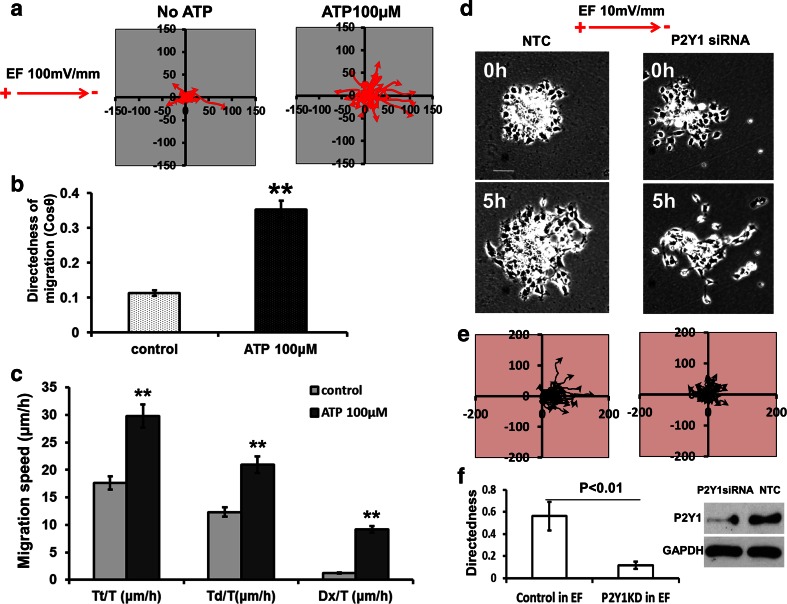Fig. 5.
Extracellular ATP increased the directed migration of SH-SY5Y cells and knock down of P2Y1 receptors inhibited directed migration in mouse neurospheres. a to c In SHSY5Y cells (human), 100 μM ATP significantly increased the directedness (Cos θ) of cells migration induced by an applied EF from 0.11 to 0.35 (EF = 100 mV/mm, n = 200). The migration speed including Trajectory rate (Tt/T), Displacement rate (Td/T) and Displacement speed along the x-axis (Dx/T) also increased significantly: Tt/T from 17.6 ± 1.2 to 29.7 ± 2.1 μm/h, Td/T from 12.3 ± 0.9 to 20.9 ± 1.5 μm/h, Dx/T from 1.2 ± 0.09 to 9.2 ± 0.6 μm/h. If cells migrated preferentially towards the right, an average directedness would be larger than 0 and approaching 1. Trajectory rate (Tt/T) is the total length of the migration trajectory of a cell (Tt) divided by the given period of time (T). Displacement rate (Td/T) is the straight-line distance between the start and end positions of a cell (Td) divided by the time (T). Displacement speed along the x-axis (Dx/T) is a cell’s displacement distance along the x-axis (Dx) divided by the time (T). **p < 0.01. d to f In cultured mouse neurospheres, knock down of P2Y1 receptor with siRNA (right column in D) significantly inhibited the directedness of cell migration compared with no siRNA control (left column in D). In E, the diagram of line plots showed cathodally directed cell migration to be reduced by inhibition of P2Y1 receptors with siRNA. Directedness (Cos θ) dropped from 0.56 to 0.12 (n = 30 ~ 35, p < 0.01). n is cell number. No EF control is shown in Fig. 2a. The western blot (right in F) shows down-regulation of P2Y1 receptor expression by siRNAP2Y1. NTC is no transfection control. GAPDH is loading control. All experiments were triplicate

